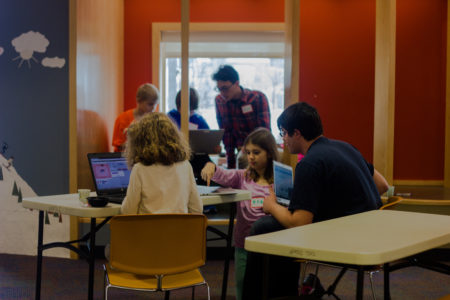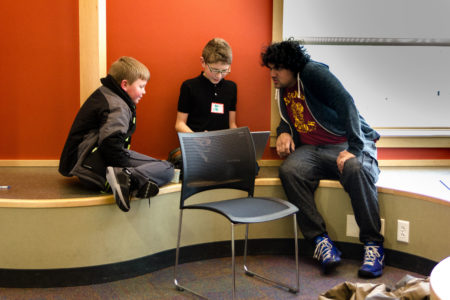
Grinnell’s After School Code Club is a weekly program in which students from the College teach programming to local middle and high school students. The program started in the fall of 2015 as an effort to expand upon school curricula, in addition to strengthening the cooperation between college and community. The teaching sessions take place at the Drake Community Library, and foster a tri-lateral relationship among the College, the school district and the library.
Monique Shore, systems administrator at Drake, described the genesis of the program as an opportunity for both the library and the College.
“The school district here did not have any computer coding in their curriculum, so about three years ago there was an effort to try and get some coding opportunities going,” Shore said. “We started off with evening sessions, there were some adults and some kids involved, and that was pretty successful.”
After those initial efforts, attendance has increased, with twelve to fifteen regular students.
“We provide the space and snacks and some of the logistics to help spread the word,” Shore said.
The classes themselves are provided primarily by Grinnell computer science students. The curriculum is mainly designed by the student leaders and has so far consisted of teaching Scratch, a visual programming language well-suited for beginners. Recently the topics have expanded to include working with the 3D printer and with mazes.
“We’re also trying to teach them some different languages. We will try a new program and then they’ll end with HTML so they can maybe make their own website. I think we’re getting there. It’s just hard to design a curriculum for a drop-in program,” said Sarah Dahlby Albright, peer education coordinator for computer science and statistics.
Dahlby Albright, similarly to Shore, expressed the vital role of the students who volunteer in teaching and building the curriculum.
“The more volunteers we have that become regular, the more diversity we’ll have in things we can do with the students,” Dahlby Albright said. “We have a list of about 12 students that are interested in going over.”
Changes in the curriculum have been matched by improvements in equipment and experience.
“One of our big challenges in the first couple of years was that we had kids that didn’t have computers, or had computers that were old and not working well,” Shore said. “One of the great things that happened is that we got a Grinnell College grant last year so we were able to purchase four laptops for use by the group. Because we got those laptops, we’ve been able to move the group to the Story Room which is a bigger space, and that’s worked really well.”
In addition to growing popularity at the library, the After School Code Club has inspired improvements in computer science education elsewhere as well.
“The code club at the library was successful, which helped get the school district to add a computer science class at the high school,” Shore said.
Despite recent successes, though, the program is not without its challenges. Shore noted a worrying gender imbalance in the program, with boys outnumbering girls by a significant margin. The organizers hope to get more girls engaged, partially by attracting female instructors.

Elizabeth Zak ’18, who has led the program in the past and designed the curriculum for the fall, said, “Representation is really important and I think that the more female instructors we have, the more girls are going to want to learn about computer science. I think it’s very important to focus on building a community and making it one where mistakes are not necessarily scorned.”
Building such a welcoming environment will take time and effort by more computer science students, present and future. Meetings of the code club are scheduled to continue every Thursday afternoon for the remainder of the semester.


























































